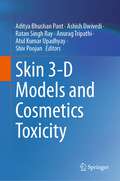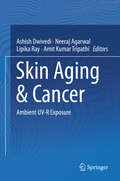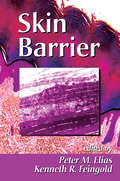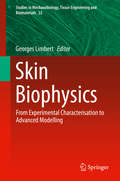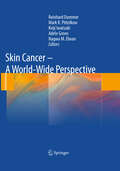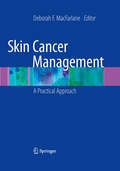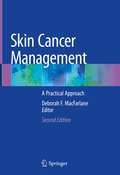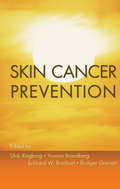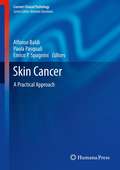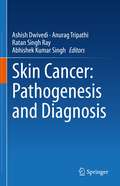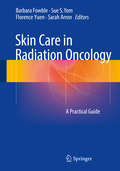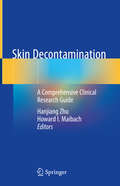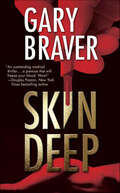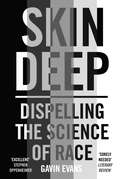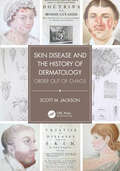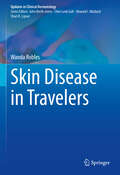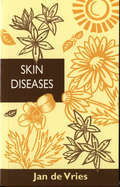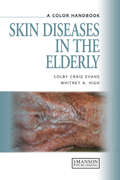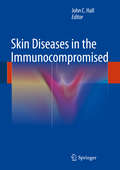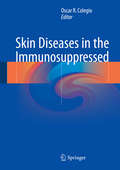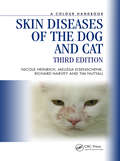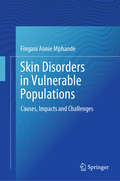- Table View
- List View
Skillslab in Pflege und Gesundheitsfachberufen: Intra- und interprofessionelle Lehrformate (Studium Pflege, Therapie, Gesundheit)
by Andrea Kerres Christiane Wissing Birgit WershofenSpaß am Lernen und Üben in realen Szenarien!Dieses Buch richtet sich an und Lehrende und Lernende im Gesundheitsbereich und bietet umfangreiche Informationen zum dem Lernkonzept Skillslab. Ob an der Berufsfachschule oder im Studium - praktische Pflegehandlungen, Patientenberatung oder Zusammenarbeit im Team lernen Berufsanfänger am besten in einem real simulierten Szenario. So können sie ihre Fertigkeiten üben und schnell Kompetenzen erweitern. Außerdem macht die Verknüpfung zwischen Theorie und Praxis Lust auf „mehr“ und die Lehrenden können das Leistungsniveau individuell anpassen. Sklillslab bietet Raum für Kreativität in der Vorbereitung, Durchführung und der Evaluation. Die erfahrenen Autoren zeigen Beispiele aus der Pflege, den Therapieberufen, Hebammen- und Rettungswesen. Bleiben Sie motiviert und mit Freude bei der Arbeit!
Skin 3-D Models and Cosmetics Toxicity
by Ratan Singh Ray Ashish Dwivedi Atul Kumar Upadhyay Anurag Tripathi Aditya Bhushan Pant Shiv PoojanEfforts are being made by research organizations and cosmetic industries worldwide to develop more precise and targeted 3D models that mimic humans for testing cosmetic and personal health care product ingredients, following a complete ban on animal testing. This book includes several subtopics dedicated to the progress made, challenges faced, roadblocks encountered, and future prospects in the development and validation of 3D models for testing these products. The book consist of an editorial and 14 themed chapters that will showcase the significant progress made so far, challenges encountered, and future prospects in the development of 3D reconstruct models.
Skin Aging & Cancer: Ambient UV-R Exposure
by Ashish Dwivedi Neeraj Agarwal Amit Kumar Tripathi Lipika RayThis book summarizes the potent effect of ultraviolet radiation (UVR) on the photoaging and cancer formation. Skin is the largest human organ which continually reconstructs itself to ensure its viability, integrity, and ability to provide protection for the body. This protection can be compromised by the aging of the skin which ultimately promotes skin inflammation, impaired wound repair, and increased risk of skin cancer. The book entails mechanistic insights into the UVR-induced immunomodulation and DNA damage in the skin to delineate the pathogenesis, and develop novel ways for prevention of photoaging of the skin cells. It also elucidates the potential of nanotechnology in the treatment of skin cancer. Further, it discusses the bioinformatics approaches to understand the molecular mechanism of photoaging and cancer formation.
Skin Barrier
by Peter M. Elias Kenneth R. FeingoldA must-have reference for any researcher or scientist interested in cutaneous protective mechanisms, this guide provides expertly researched chapters on every aspect of stratum corneum structure, function, and development, as well as detailed sections on barrier-repair strategies and the role of barrier function in diseases such as atopic dermatiti
Skin Biophysics: From Experimental Characterisation to Advanced Modelling (Studies in Mechanobiology, Tissue Engineering and Biomaterials #22)
by Georges LimbertThis book presents state-of-the-art experimental and modelling techniques for skin biophysics that are currently used in academic and industrial research. It also identifies current and future challenges, as well as a growing number of opportunities in this exciting research field. The book covers the basics of skin physiology, biology, microstructural and material properties, and progressively introduces the reader to established experimental characterisation protocols and modelling approaches. Advanced topics in modelling theories and numerical implementation are also presented.The book focusses especially on: 1. Basic physiology, molecular biology, microstructural and material properties of the skin. 2. Experimental characterisation techniques for the skin (including imaging): in vivo and in vitro techniques and combination of those with in silico approaches. 3. State-of-the-art constitutive models of the skin: elastic, anelastic and mechanobiological formulations (e.g. growth, ageing, healing). 4. Applications: mechanics, damage, biological growth, healing, ageing and skin tribology.This book is addressed to postgraduate students in biomedical/mechanical/civil engineering, (bio)physics and applied mathematics, postdoctoral researchers, as well as scientists and engineers working in academia and industry engaged in skin research, particularly, if at the cross-roads of physical experiments, imaging and modelling. The book is also be of interest to clinicians/biologists who wish to learn about the possibilities offered by modern engineering techniques for skin science research and, by so doing, provide them with an incentive to broaden their outlook, engage more widely with the non-clinical research communities and, ultimately, help cross-fertilising new ideas that will lead to better treatment plans and engineering solutions.
Skin Cancer - A World-Wide Perspective
by Keiji Iwatsuki Mark R. Pittelkow Adèle Green Nagwa M. Elwan Reinhard DummerOver the last decades the incidence of skin cancers is dramatically increasing world-wide. This is not only confined to the incidence of melanoma but includes also other skin cancers such as basal cell carcinomas. Based on the recent WHO classification of skin cancers, this lavishly illustrated reference book covers comprehensively the epidemiology, histology and pathology, as well as diagnostic signs and treatment options of skin cancers. Homogenously and reader-friendly structured, it links the diagnostic and genetic features of each disease in order to guide the reader to the most appropriate therapeutic strategies for the best possible treatment outcome. In order to demonstrate the world wide activities in the field, all chapters cover the variations of the individual experiences and expertise in different nations.
Skin Cancer Management
by Deborah MacfarlaneThe incidence of skin cancer continues to rise, as do the challenges physicians face in treating the growing population of skin cancer patients. Skin Cancer Management: A Practical Approach addresses the spectrum of skin cancers from the precancerous to the inoperable. A wide selection of medical treatments and surgical procedures are described in detail and supplemented with an abundance of full-color figures. Numerous case studies help to illustrate the various techniques. Additional highlights of the book include a discussion of potential complications and their management in each chapter; boxed insets that emphasize the most important clinical facts; and one-of-a-kind chapters on radiologic imaging of head and neck skin cancer, management of skin cancer in skin of color, and intralesional and perilesional treatment of skin cancers. Skin Cancer Management: A Practical Approach covers the state-of-the art in skin cancer treatment with concision and clarity. This highly informative book is a one-stop resource for the physician looking to make the best possible choices in their daily practice.
Skin Cancer Management: A Practical Approach
by Deborah F. MacFarlaneThe incidence of skin cancer continues to rise, as do the challenges physicians face in treating the growing population of skin cancer patients. Skin Cancer Management: A Practical Approach, 2nd edition addresses the spectrum of skin cancers from the precancerous to the inoperable. In this revised and updated edition, a wide selection of medical treatments and surgical procedures are described in detail and supplemented with an abundance of full-color figures. Numerous case studies help to illustrate the various techniques.
Skin Cancer Prevention
by Ulrik Ringborg Yvonne Brandberg Rudiger Greinert Eckhard W. BreitbartCoedited by the President of the European Society of Skin Cancer Prevention, this guide provides a detailed overview of the three most common forms of skin cancer-basal cell, squamous cell, and melanoma-and authoritatively guides readers through current research related to the epidemiology, primary and secondary prevention, and identification of th
Skin Cancer: A Practical Approach
by Paola Pasquali Alfonso Baldi Enrico P SpugniniSkin Cancer: A Practical Approach presents a comprehensive and up to date overview on skin cancer. With an emphasis on practical aspects that will set the basis for guidelines of treatment, the volume presents different diagnostic tools to help physicians obtain the proper diagnosis. Written by a worldwide base of experts selected on their recognized expertise on the different themes discussed, Skin Cancer: A Practical Approach is a valuable resource for investigators in the field of skin cancer, including pathologists, medical and surgical oncologists, dermatologists, general surgeons, and veterinary oncologists
Skin Cancer: Pathogenesis and Diagnosis
by Ratan Singh Ray Ashish Dwivedi Abhishek Kumar Singh Anurag TripathiThis book highlights the molecular and cellular mechanisms involved in the initiation and progression of skin cancer. It also explains the role of the environment in skin cancer development and explores the potential of microbiome in the diagnosis, prevention and treatment of skin cancer. The book also presents potential biomarkers for early detection of skin cancer and discusses recent advances in skin cancer prevention and treatment using photodynamic therapy. Lastly, it summarizes the applications of biomedical engineering, non-coding and nanotechnology in the diagnosis and therapeutics in skin cancer. It is a valuable resource for investigators in the field of skin cancer, including pathologists, medical and surgical oncologists, and dermatologists.
Skin Care in Radiation Oncology
by Barbara Fowble Sue S. Yom Florence Yuen Sarah ArronThis book serves as a practical guide for the prevention and treatment of radiation dermatitis. Skin toxicity caused by radiation treatment is common among cancer patients and minimizing the frequency and severity of these reactions improves quality of life and prevents interruptions that can compromise local-regional control. Each chapter is devoted to a specific disease site, such as the head and neck, breast, gastrointestinal, genitourinary, gynecologic, and central nervous system. Pediatric malignancies and wound care for locally advanced cancers are also discussed. For each topic, the range and frequency of the observed skin reactions, factors influencing these reactions, the typical course of each reaction and its resolution, and the interventions used are presented. This book provides evidence where it exists for the specific interventions and an extensive illustration program depicts the various reactions and their response to treatment protocols. Skin Care in Radiation Oncology: A Practical Guide presents a framework for patient care in an era of advancing technology and systemic and targeted therapies and is a valuable resource for radiation oncologists, dermatologists, and residents.
Skin Decontamination: A Comprehensive Clinical Research Guide
by Howard I. Maibach Hanjiang ZhuThe skin is the first line of defense against chemical warfare agents including nerve agents and toxic industrial chemicals, providing a possible barrier or delay to systemic distribution. However, some chemicals act directly on the skin including vesicants sulfur mustard and corrosive compounds such as strong acids or bases, and do not have to gain access to systemic circulation to cause extensive skin damage. Early and rapid skin decontamination is extremely important following exposure to chemical warfare agents and toxic industrial chemicals because it decreases serious skin damage to the patient and, potentially, their doctor. This multi-authored international text pulls together a century of decontamination research and helps the reader expedite solutions that will decrease morbidity and mortality. Complete with dozens of hiqh quality photographs and illustrations, Skin Decontamination aids industrial hygiene, dermatology, occupational physicians and those involved in the public health arena.
Skin Deep
by Gary BraverSomeone is killing the most alluring women of Boston. Someone whose keen eye for beauty masks a twisted mind. Someone who insinuates himself into his victims' lives and leaves them with nothing but an elegant black stocking knotted around their necks.Homicide detective Lieutenant Steve Markarian must stop the killer before another woman is sacrificed. The stakes increase when he realizes his own wife has caught the killer's eye.In this stunning psychological thriller, bestselling author Gary Braver explores the nature of beauty, and the forbidding yearnings that kill in its name.At the Publisher's request, this title is being sold without Digital Rights Management Software (DRM) applied.
Skin Deep: Journeys in the Divisive Science of Race
by Gavin EvansEverything you need to know about race (but were afraid to ask). MYTH: Early Europeans were white. REALITY: The first Europeans had dark skin, black, curly hair and blue eyes. MYTH: Between 50,000 and 70,000 years ago, a &‘cognitive revolution&’ led to the birth of culture in Europe. REALITY: Modern intelligence evolved tens of thousands of years earlier, leading to the birth of culture in Africa.Does racism have a rational basis in science? In Skin Deep, Gavin Evans tackles head-on the debate that has been raging on internet message boards and in academic journals. No longer limited to the fringe, race-based studies of intelligence have been discussed by thinkers such as Sam Harris and Jordan Peterson. If these studies were true, they would provide an intellectual justification for inequality and discrimination. Examining the latest research on how intelligence develops and laying out new discoveries in genetics, palaeontology, archaeology and anthropology to unearth the truth about our shared past, Skin Deep demolishes the pernicious myth that our race is our destiny and instead reveals what really makes us who we are.
Skin Disease and the History of Dermatology: Order out of Chaos
by Scott JacksonThis text is both a history of skin disease and a history of dermatology, telling the human historical experience of skin disease and how we have come to know what we know about the skin and its myriad diseases over the course of four millennia, looking at key figures in life and literature and key events such as the Black Death and the eradication of smallpox. *Examines how the history of skin disease fits into the larger picture of the history of each age *Provides dermatological insight into major events and personalities from history *Offers a unique perspective on the history of each age
Skin Disease in Travelers (Updates in Clinical Dermatology)
by Wanda RoblesOne of the most frequent medical complaints among travelers is dermatologically related. As many as one in ten people are affected during travel itself with others not experiencing symptoms until well after they have returned from their trip. This book provides comprehensive information on infectious diseases; bacterial, viral, and fungal as well as skin diseases due to physical injuries and or exposure to contaminated foods. It compiles common dermatoses in one place to provide an easy-to-read tool for diagnosis and advice on further investigation and treatment of the skin disease. Featuring contributions from experts around the world, this book covers a wide variety of skin diseases. Where most literature focuses on the various skin issues from traveling to tropical locations, this title is inclusive of dermatoses found in other locales. Chapters also includes tables and figures to illustrate each disease.Skin Disease in Travelers isa must-have resource for for dermatologists, dermatology residents and medical students, and general practitioners.
Skin Diseases (By Appointment Only Ser.)
by Jan de VriesIn this latest book in the 'By Appointment Only' series, Jan de Vries deals with the ever increasing problems of skin diseases. Drawing on over 35 years' experience, he writes about causes, effects and ways of alleviating irritating and sometimes disfiguring problems. In Skin Diseases Jan de Vries deals with everything from acne, allergies and dermatitis, to the latest developments in the treatment of psoriasis. He explains why infantile eczema is so much more prolific now and how it can be helped by simply eliminating cow's milk from the diet. He discusses some of the more obscure fungal conditions which are prevalent in today's society, explains why there is such a high incidence and how these can be overcome by simple herbal remedies and naturopathic treatment in the home. This book is essential reading for anyone who has suffered from any irritating skin condition, and generally offers sensible guidelines for healthier living.
Skin Diseases in Females
by Rashmi Sarkar Surabhi SinhaThis book covers dermatological and related esthetic concerns specific to female patients. Since knowing what’s normal is as important as knowing what’s not, first chapters covers physiological differences in the skin of women and the changes during puberty, pregnancy, and menopause. Certain commonly encountered dermatoses are more frequent in females – chronic telogen effluvium, rosacea, perioral dermatitis, pigmented contact (cosmetic) dermatitis, etc., which are explained in a more focused manner. Dermatoses exclusive to females involving the vulva is discussed at length. These include common papulosquamous conditions such as psoriasis, lichen planus, and lichen sclerosus as well as the uncommon but challenging plasma cell vulvitis. Breast dermatoses also are predominantly encountered in women and are described in detail in this book. Importantly, the safety of drugs and biologics in pregnancy and lactation have been covered too. One section is dedicated to the emotional and psychological burden of skin disease in women and certain disorders requiring psychiatric intervention such as obsessive-compulsive disorder (trichotillomania, trichotemnomania) and body dysmorphic disorder. Furthermore, commonly used cosmeceuticals and frequently performed esthetic procedures such as chemical peels, botulinum toxin, and soft tissue augmentation (fillers) are well explained. Skin diseases in females can cause a significant emotional and psychological impact that can sometimes be more serious than the physical impact. There is a paucity of comprehensive published literature in both journal and books and this book aims to fill that gap. This book is meant as a resource for dermatology residents and trainees, practitioners, and teachers.
Skin Diseases in the Elderly: A Color Handbook
by Colby Evans Whitney HighIn this new color handbook, the authors deal systematically with those skin conditions that are particular to or more common in the elderly covering testing, diagnosis and treatment options. Given ageing populations the need for such a book is urgent. More and more elderly patients will seek care for a variety of skin conditions, ranging from eczem
Skin Diseases in the Immunocompromised
by John C. HallAs the number of surviving immune suppressed patients continues its rapid increase, the skin manifestations have become increasingly important AIDS patients and renal, heart, liver, bone marrow and lung transplant patients are surviving longer and are often experiencing skin side effects of immunity suppression Diabetes is exploding in the USA and offers its own unique brand of immune suppressed skin diseases. Immunosuppressive drugs are being used more frequently and newer biologics and tyrosine kinase drugs have added to new categories of immune suppressed patients. This book aims to clearly elucidate the signs of immune suppressed skin disease to afford early diagnosis and management of this ever-increasing, diverse group of illnesses.
Skin Diseases in the Immunosuppressed
by Oscar R. ColegioIn this book, expert dermatologists review state of the art knowledge concerning the clinical presentation and management of cutaneous diseases that develop in immunosuppressed individuals. A major aim is to enable dermatologists to identify the specific immunosuppressant responsible for a specific adverse effect in patients receiving a complex medication regimen in the setting of transplantation. Further, the book will help the dermatologist to distinguish the cutaneous adverse effects of antiviral agents from effects arising directly from advancing HIV disease. Recognition of the cutaneous manifestations of often less common primary immunodeficiencies will also be emphasized. A final goal is to improve patient outcomes by identifying treatment strategies for skin disease arising in the immunosuppressed state. This book will be invaluable for a broad audience, from practicing dermatologists to medical and dermatology residents.
Skin Diseases of the Dog and Cat, Third Edition (Veterinary Color Handbook Series)
by Tim Nuttall Richard G. Harvey Nicole A. Heinrich Melissa EisenschenkKey features: • Completely updated in response to developments in veterinary dermatology over the last decade • Superb and generously sized colour photographs and diagrams • Describes lesion identification and diagnostic techniques in great detail, especially useful for revision • Chapters are organized based on symptoms, and each chapter has a decision tree: gives basic and practical guidance. • Clear user-friendly design with one condition per page (or spread of pages) • Referenced thoughout to give the clinician access to the literature A Colour Handbook of Skin Diseases of the Dog and Cat was one of the first books to bring key information about skin diseases to clinicians in an easy-to-use problem-oriented format. This fully revised and updated Third Edition responds to the huge growth in knowledge about skin conditions over the last decade, including the discovery of new conditions, the development of new approaches to management, and effective new treatment options. 13 chapters covering over 120 skin, claw and ear conditions classified by their principle presenting sign. Concise, systematically structured text covering definition, aetiology and pathogenesis, clinical features, differential diagnoses, diagnostic tests and management. Flow charts in each chapter to help clinicians get to the right diagnosis. Special focus on diseases affecting paediatric patients as well as chapters discussing paw, ear and nasal planum diseases. Explanation of new treatments for atopic dermatitis. Over 350 superb colour photographs and diagrams, mostly new for this this edition. A focus on clinical practice and the need to explain the disease to the owner. Up-to-date and fully referenced throughout. This practical book continues to provide an entirely comprehensive guide to the diagnosis and management of veterinary skin conditions, in a format that is easily accessible for busy clinicians.
Skin Disorders in Migrants
by Bernard Naafs Aldo Morrone Roderick HayThis richly illustrated book is a comprehensive guide to the dermatologic disorders that may be encountered in refugees and other migrants. It will equip readers to diagnose and treat a diverse range of skin diseases and conditions, including, but not limited to, infections caused by bacteria, viruses, fungi, and parasites, dermatologic manifestations of sexually transmitted diseases, dermatoses associated with malnutrition, pigmentary disorders, bullous diseases, connective tissue diseases, and benign and malignant cutaneous neoplasias. Attention is drawn to various neglected tropical skin diseases and to the characteristic signs of torture and genital mutilations. Helpful information is also provided on the significance of skin color and the relevance of ethnic and genetic factors. The clinical chapters are complemented by discussion of the circumstances that give rise to migration, such as poverty, war, and environmental conditions. This enables the reader to gain a more rounded understanding of patients’ circumstances that in turn will positively impact on patient care. This book will be of wide interest to dermatologists, whether experienced or in training, as well as to general physicians and researchers.
Skin Disorders in Vulnerable Populations: Causes, Impacts and Challenges
by Fingani Annie MphandeThis book focuses on neglected skin diseases and conditions in resource-poor countries through the lens of livelihoods. These diseases, when neglected, not only affect the skin, but also joint movement and physical appearance, severely influencing the lives and livelihoods of individuals and families in vulnerable communities. The book explores why neglected skin diseases thrive in resource-poor countries, and considers how this cycle might be broken by looking at the impact on livelihoods and access to healthcare in affected communities. The research is shaped by three guiding questions: Firstly, why have some measures been successful in one part of a population and not the other? Secondly, what is unique about vulnerable populations in various parts of the world? And thirdly, can the cycle of debilitating skin diseases and conditions in resource-poor countries be broken? In addressing these concerns, the book excavates past and present efforts in public health measures to combat these diseases, considers the impact of culture and livelihoods, and reviews some of the milestones in disease elimination and eradication. This book will be an indispensable source for health service planners, administrators and practitioners working with vulnerable populations, as well as graduate students and researchers in public health.

